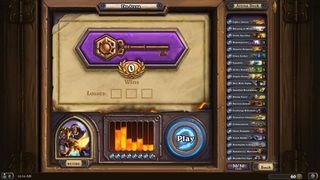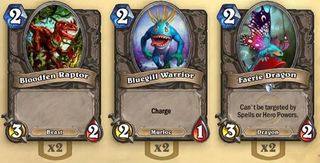The Arena is your friend
Purchasing a single pack of cards costs 100 gold (or 2 for $2.99), while admission to the Arena costs 150 gold (or $1.99). You're guaranteed a pack at the end of your run, so worst case scenario (finishing with 0 wins) you're only at a net loss of roughly 40-50 gold.
According to Arenamastery.com , which has tracked the average rewards of thousands of Hearthstone Arena runs, 3 wins typically nets 41 gold in addition to a pack, some dust, and possibly additional cards. At 4 wins that gold count goes up to 66, and keeps climbing from there. In other words, from a money/gold to experience/enjoyment standpoint, spending your gold buying into Arena runs is much more cost-effective than purchasing packs outright. At 7 wins the gold count is up to 166 (again, on average), so that means another Arena run and a pack for free.

Take note that the drafting (card picking) phase of an Arena run isn't timed, so if you aren't sure which card to pick, take your time. Examine your mana curve. Look for card synergy. Tab out and do some research if you have to. (Important note: the cards you draft don't head to your collection after your Arena run , so don't worry about picking Rares or Legendaries just for the sake of your collection. Always pick the best card of the three for your deck, even if it's a common.)
The drafting phase is arguably the most important part of the Arena for beginners, as it will determine if your deck is on the same power level as your opponents. In constructed, a beginner won't stand a chance, as they simply won't have the card pool (read: legendaries) to stand a fighting chance without dropping hundreds of dollars. Arena decks only play other Arena decks, so as long as you draft well, you and your opponents will be on equal footing.
Learn what cards are worth playing
This is important when building a constructed deck, but especially so when drafting cards for the Arena.
Low toughness minions are largely useless without an additional ability, such as Charge (effectively turning them into a targeted burn spell) or Divine Shield (letting them survive more than a single hit). After all, the 5/1 for 3 Magma Rager looks menacing, but he's easily taken out by a measly 1/1.
Use battlecry minions to your advantage, as your opponent may not have accounted for them when calculating future trades. Cards such as Shattered-Sun Cleric and Dark Iron Dwarf are very powerful for this reason.
The biggest gaming news, reviews and hardware deals
Keep up to date with the most important stories and the best deals, as picked by the PC Gamer team.
Learn the default cost for different stats and abilities, and use that knowledge to determine if a card is worth using
- 2 cost should get you a 3/2, often with an ability.
- 3 cost = 3/3 with a good ability.
- 4 cost - The gold standard is Chillwind Yeti, a vanilla 4/5. Also very strong is Senjin Shieldmasta; compared to the Yeti it trades 1 attack for Taunt — well worth it.
Appreciate when cards have good synergy together, but make sure they still have value on their own. You won't always get the two at the same time.

Don't underestimate the power of large, expensive, powerful dudes. As a former MTG player I was used to keeping my mana curve low, only including a few things at 6 or more mana cost. In Hearthstone, since you always get a mana crystal every turn, you don't have to worry about missing a land drop.This doesn't mean you should stack your deck with 6-8 cost fatties, but certainly don't be afraid of including a few to take advantage of your large late-game mana pool.
Avoid cards that only deal damage to the opposing Hero. Board control is king, so inability to target minions makes cards like Sinister Strike and Headcrack poor choices.
Stealth states "Can't be attacked or targeted until it does damage," but it actually means "can't be attacked or targeted by ENEMIES until it does damage." In other words, you can buff your stealth minions before bringing them out of stealth.
With over two decades covering videogames, Tim has been there from the beginning. In his case, that meant playing Elite in 'co-op' on a BBC Micro (one player uses the movement keys, the other shoots) until his parents finally caved and bought an Amstrad CPC 6128. These days, when not steering the good ship PC Gamer, Tim spends his time complaining that all Priest mains in Hearthstone are degenerates and raiding in Destiny 2. He's almost certainly doing one of these right now.
Most Popular







